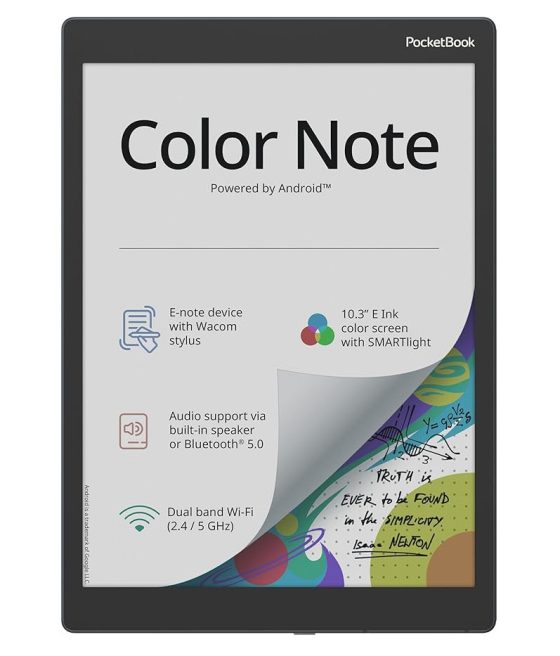PocketBook has released another eNote with a color E Ink screen called the PocketBook Color Note, and it has a unique screen unlike any other eNote on the current market.
At first I couldn’t figure out why PocketBook would release another eNote with a 10.3″ Kaleido 3 screen when they just released the PocketBook InkPad Eo a few months ago with the same screen, but this new model features a different design, and the screen is different too, even though it appears the same on the surface.
Doing a bit of digging on PocketBook’s website, I discovered some unusual details about the specs of the screen. Other color ereaders and eNotes with Kaleido screens use a regular E Ink Carta screen with a color filter over the top.
This new model uses a Mobius screen instead, which is one of E Ink’s older technologies that uses a flexible plastic backplane instead of thin glass like Carta screens. Because of this, Mobius screens are a lot more durable and resist cracking unlike glass, and they’re also lighter. In fact, this new model is 80 grams lighter than the PocketBook Eo with the same size screen.
However, this new screen comes with some serious drawbacks in terms of resolution. Most devices with Kaleido 3 screens have 300 ppi for BW content and 150 ppi for color. According to PocketBook’s spec sheet, the new PocketBook Color Note only has 227 ppi for BW content and a paltry 76 ppi for color.
On top of that, the new PocketBook Color Note is $50 more expensive than the Eo at $599 (actually, the PocketBook InkPad Eo is currently on sale for $499 so this new model is $100 more expensive with half the color resolution).
The new model also has half the internal storage space at 32GB, and it has a slower 1.5 GHz quad-core CPU instead of the 2.3 GHz octa-core CPU on the Eo.
It has a Wacom touchscreen for notetaking, and a capacitive touchscreen for finger touch. There’s a rotation sensor, a microSD card slot, a USB-C port with OTG support, it has a mono speaker and a mic, there’s 4GB of RAM, and it has a frontlight with adjustable color temperature (it also features ComfortGaze™, unlike the Eo). And it runs Android 12 instead of Android 11 like the Eo.
PocketBook is a hard company to figure out. They’ve been releasing new devices all the time lately, some with Android and some with their original Linux-based software, and there’s a lot of overlap between the various models.
The new PocketBook Color Note is available to order now on PocketBook’s Amazon store for $599 with free shipping.


I’m wondering if these devices are selling well.
Ouch! Sounded interesting … until I hit the resolution numbers. That, slower CPU and less storage, all for more money? No thanks.
I should like to see Mobius screens, especially in more expensive, larger devices, however, ya gotta keep the rest of the quality the same.
Why do Pocketbook release something that’s almost dead on arrival? Android 12 at the end of 2024? And then a low resolution, bad other specs plus a premium price? Who will buy this rubbish? And what do they consume at Pocketbook to assume this is a good product?
It’s like last year when they released the InkPad X Pro with Android 8.1 for $420, and everyone thought they were crazy. Now the price is down to $279 and still nobody wants to buy it.
For me a color and unbreakable e-paper screen is one of the most desired characteristics in an e-paper note device. For that alone it’s worth it for me. Who knows if there will be future generations that overall improve the device.
I’d love to know how well and how fast it can play video, knowing that in this 2024 the E-Ink company has improved the FPS of their e-ink screens.
I also want to know if the tips of a WACOM pen for the device will wear away or if I can actually get tips that wont wear with writing (I prefer durability over “sensations” of writing on real paper).
These types of devices usually have a front layer that can still break, but the screen itself is flexible and more durable without the glass backing. In fact Onyx’s first eNote used a Mobius screen and it didn’t have a front layer and the screen was easy to damage. Even though it doesn’t crack, you could leave permanent dents and scratches on the screen just by writing too hard. And you could feel it flexing when pressing with a finger, so they really need some kind of protective front layer.